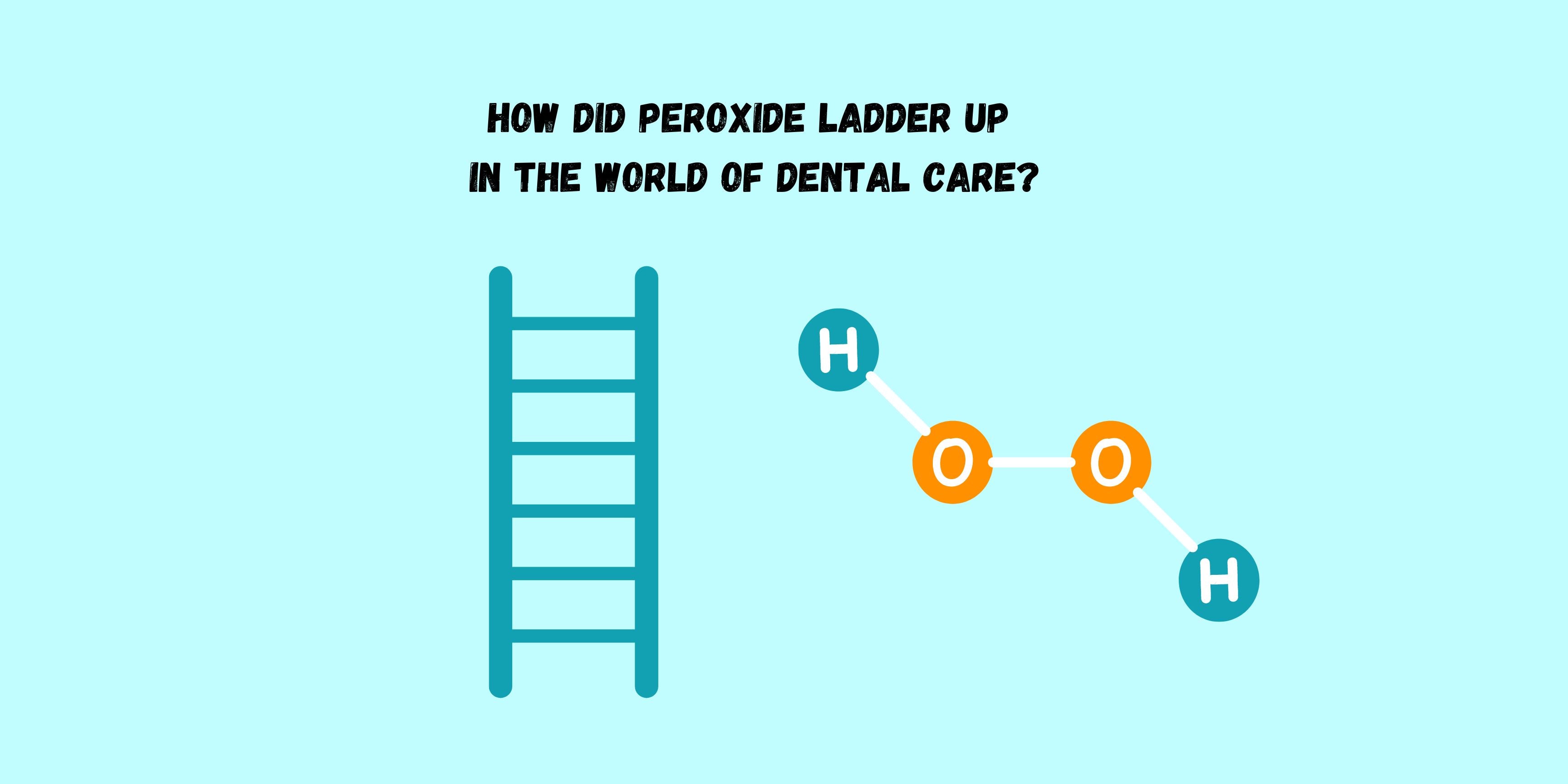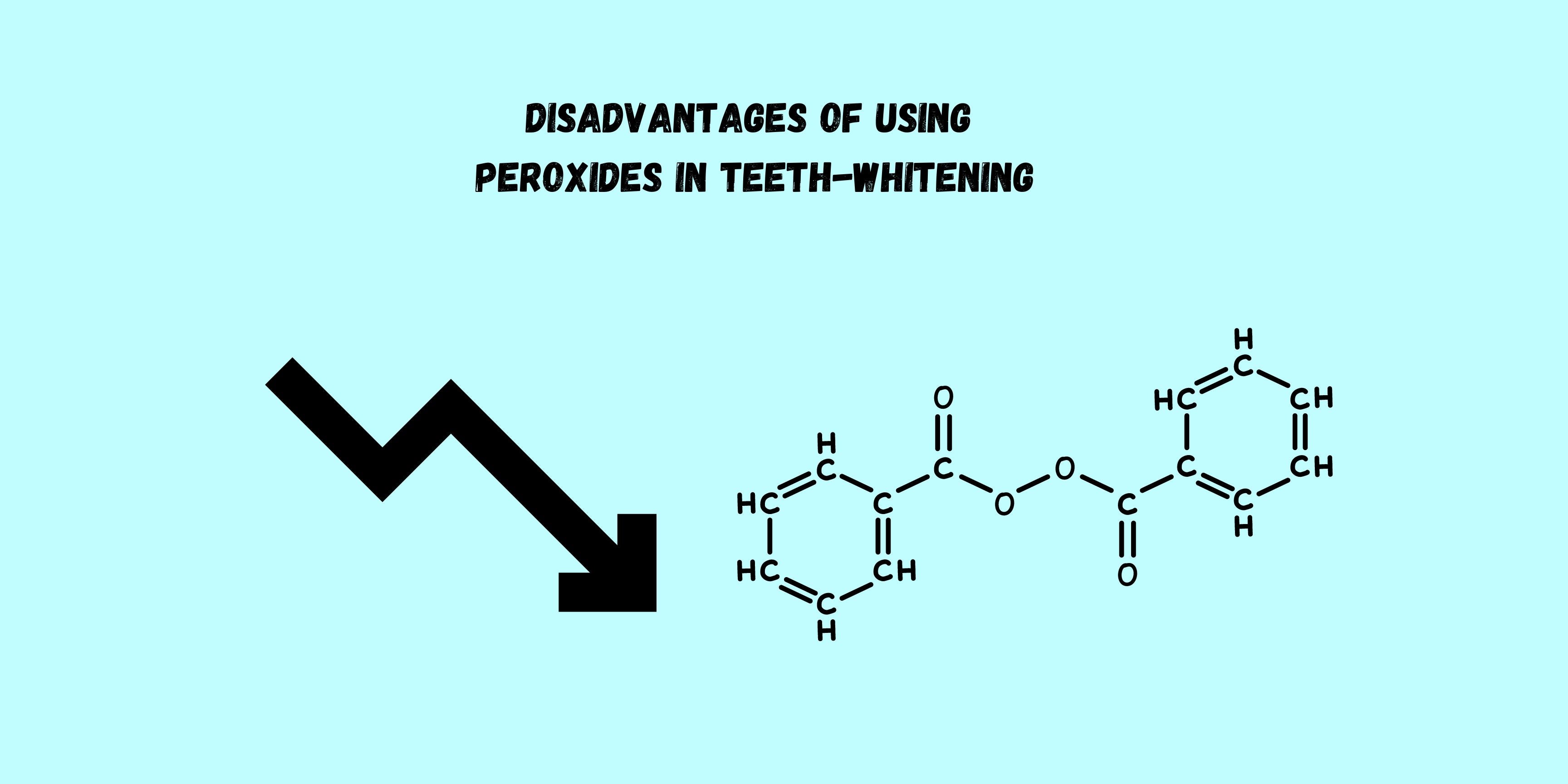Whether you ask a pal in your circle or look up teeth-whitening solutions online, you’ll find hydrogen peroxide and carbamide peroxide to be the 2 solutions that lurch forward as the top responses. And this has been game for long.
Before we take you through the good, the bad, and the in-betweens of peroxide, a little admission from our side. Peroxides are truly effective in driving your stains out. But at what cost?
Teeth-whitening solutions shouldn’t come with aches, burns, itches, and a dozen dental discretions. To incorporate them into your everyday routine, they have to be safe, simple, and pocket-friendly.
In this blog, we tell the tale of how peroxides are losing consumer trust and market share in favour of safe dental equipment that commits to giving your teeth a reliable and user-friendly whitening swipe. Let’s begin!
Table of Contents
How did peroxide ladder up in the world of dental care?

Our predecessors shared our modern obsession with flashy smiles. They tried a lot of different techniques centuries ago to keep their teeth bright and sparkling. The ancient Egyptians used wine vinegar, ground pumice stones, and chew sticks to whiten teeth. The ancient Romans used chew sticks and a mixture of goat milk and stale urine. Nitric acid became popular as a teeth-whitening technique in the 1600s.
It was not until the late 1800s that dentists started utilising chlorine as a teeth-whitening solution. It gained popularity quickly but hydrogen peroxide took the stage in the early 20th century. The first peroxide-based whitening products were introduced by dentist William Klusimer in 1960, and they were popular for roughly 10 years. On the other hand, stronger formulations also meant harsher gums.
In 1989, carbamide peroxide—a kinder substitute for hydrogen peroxide—was introduced. This hydrogen peroxide and urea mixture turned out to be less harsh on gum tissue and to have fewer side effects. However, greater amounts were required to provide the same whitening effects because it's a diluted form of hydrogen peroxide.
Hydrogen peroxide and carbamide peroxide continue to be the industry leaders today. They work well at whitening and lightening teeth, but they have some critical disadvantages as well. After using treatments containing peroxide, many people feel burning, itching, redness, swelling, and sensitive teeth.
Countries all over the world have consequently placed limitations on or outright banned cosmetics that use hydrogen peroxide. For instance, in the EU, goods containing more than 6% hydrogen peroxide are forbidden; however, in Canada, goods containing more than 3% hydrogen peroxide must present convincing proof of safety. The use of hydrogen peroxide in cosmetics is completely banned in Japan.
Whether you're in Europe, North America, or Asia, it's crucial to pay attention to the cautions regarding peroxide-based whitening products.
Disadvantages of using peroxides in teeth-whitening

According to a 2014 study, people who used a 35% hydrogen peroxide product for in-office teeth whitening experienced dental irritation. Teeth with restorations experienced greater sensitivity than teeth without them. Even though the bleaching procedure successfully whitened the teeth, it hurt more—especially the top lateral incisors.
Another study showed that using treatment procedures containing 5.3% hydrogen peroxide, 10% carbamide peroxide, and 15% carbamide peroxide significantly increased the amount of enamel wear.
Ingestion of carbamide peroxide may result in poisoning. Small doses of low-concentration (up to 14%) carbamide peroxide may cause mild symptoms like nausea, vomiting, or sore throats, but they won't be life-threatening. Larger doses, particularly at concentrations higher than 15%, can, however, have more harmful effects, like burns to the mouth, oesophagus, or stomach. Additionally, there's a chance of a gas embolism, which can result in symptoms like confusion, chest pain, and difficulty breathing. This can even cause a heart attack or stroke. Common adverse effects include gum inflammation and tooth discomfort.
Hydrogen peroxide should also only be used in small amounts because of possible risks. Due to its strong reactivity, teeth may become more sensitive and long-term use can have a detrimental effect on dental health because of its chronic inflammation of the teeth and gums. While it could work quickly for last-minute events like proms or weddings, regular use can weaken teeth and cause porous enamel. Furthermore, using hydrogen peroxide for an extended period might give teeth an unnatural appearance. Despite its benefits, using hydrogen peroxide for teeth whitening requires cautious thought before making the decision. It is advised to speak with a dental expert to properly balance the advantages and disadvantages.
Also Read - The Benefits of Using Vegan and Cruelty-Free Teeth Whitening Products
How Purexa is Revolutionizing Oral Care: The Future of Peroxide-Free Teeth Whitening

Hydrogen peroxide and carbamide peroxide have long been the standard teeth-whitening products in the dental field. Even though they work well at getting rid of stains, they have a lot of unavoidable disadvantages.
Reports of burning, itching, and increased tooth sensitivity following use have damaged their reputation. Furthermore, due to safety concerns, regulatory authorities worldwide have placed restrictions on items that contain peroxide.
In light of these worries, teeth whitening solutions without peroxide appear to be a promising substitute for dental care in the future. By doing away with the harsh chemicals that come with peroxides, these treatments put safety, ease of use, and affordability first without sacrificing efficacy.
PUREXA's innovative Teeth Whitening Pen for Instant teeth whitening is a peroxide-free and super-easy alternative to traditional whitening methods. With no harsh chemicals and a portable build, it promises a professional-grade smile makeover.
Bottom Line

In summary, peroxide-free teeth whitening appears to be the future of dental treatment, providing a more secure, pleasant, and efficient substitute for customary techniques. The widespread concerns surrounding hydrogen peroxide and carbamide peroxide, such as tooth sensitivity and regulatory restrictions, highlight the need for gentler solutions in the dental industry.
PUREXA's Teeth Whitening Pen stands at the forefront of this innovative shift, providing a peroxide-free formula that prioritises safety and convenience without compromising on results. With its easy application and gentle approach, it addresses the drawbacks associated with peroxide-based products while delivering professional-grade whitening.
With customers prioritising safety and ease of use in their oral care regimens, peroxide-free whitening agents are receiving much-needed attention. Let’s watch the future of oral care unfold together in full force! Wishing you happy smiles and cheery times.
Written by Dr. Shipra Jaiswal, BDS, MDS, a Periodontist and Gums Specialist
4 comments
Orange Dental offers top-quality Dental Services in Toronto, ensuring healthy smiles with expert care and advanced treatments. Visit us for your dental needs!
This is a great step forward for both dental professionals and patients. Excited to see where the future of oral care takes us!
It’s exciting to see how new, safer options are evolving for brighter smiles. Keep up the great work in providing such valuable information!
The emphasis on safety and gentleness makes these products an attractive option for individuals with sensitive teeth or gums, offering a solution that delivers results without causing discomfort or irritation.